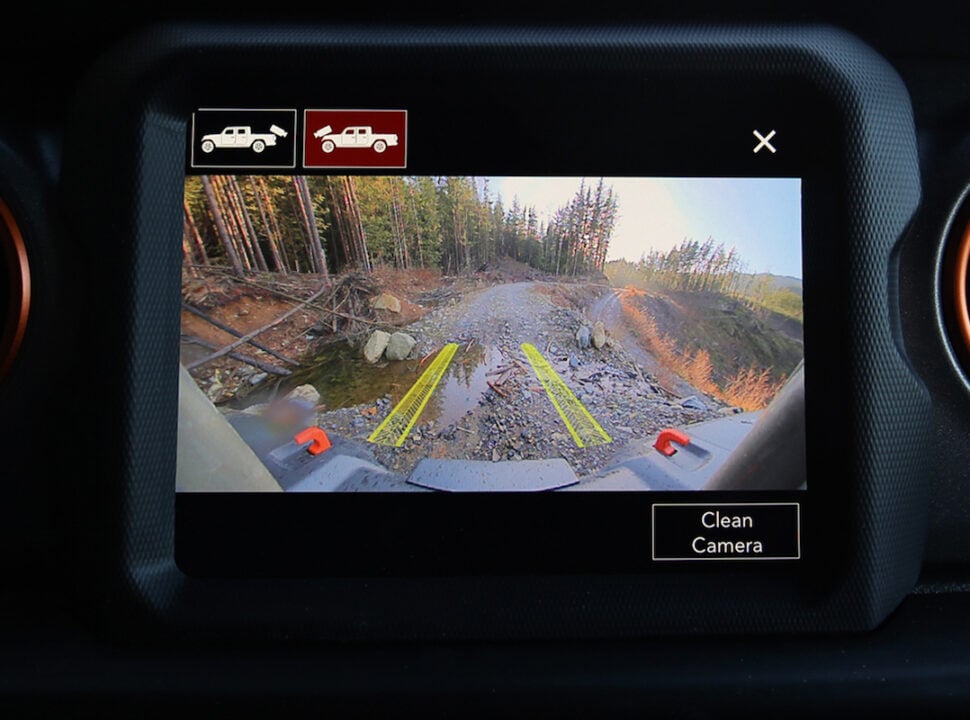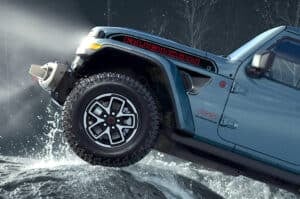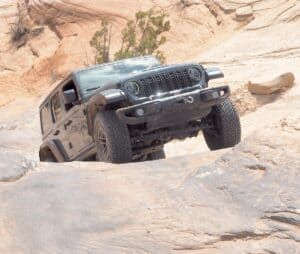There are many advantages to living in British Columbia. The mild climate sits atop my list, but I also relish having the ability to escape the grind on short notice and venture out to explore all of this province’s natural beauty. I live in a region populated by mountain vistas and scenic rivers and lakes so on a whim I can find a forestry access road, gain some altitude, and get a better lay of the land or discover a secluded lake.

Over the past year, I have tested two models of the new Jeep Gladiator, a pick-up variant of the popular Jeep Wrangler, and both proved well-suited for climbing these treacherous primitive roads, clambering through washouts, and traipsing over scree slopes with stunning ease. First up was the 2020 Jeep Gladiator Rubicon, and most recently, I got to sample the 2021 Jeep Gladiator Mojave.
The Gladiator is essentially a four-door Wrangler that has been stretched to accept a five-foot pick-up bed (itself a revision of that used for FCA’s RAM 1500 pickup) in place of the enclosed rear cargo area. This winning combination works so well that the Gladiator won the esteemed North American Truck-of-the-Year title and a long list of other awards.
The Gladiator Rubicon and Mojave Trims Are Built for Adventure
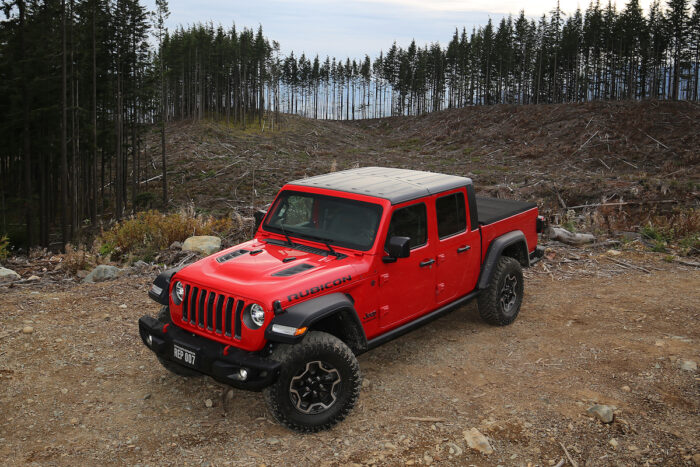
Upon introduction for the model year 2020, there were just three models of Gladiator offered- Sport S, Overland, and Rubicon; along with some special editions, including the 2020 Gladiator “Three O Five” Edition and 2020 Jeep Gladiator North Edition. For 2021, there are now seven models of Gladiator in the Jeep portfolio – Sports S, Willys, Overland, 80th Anniversary Edition, Rubicon, Mojave, and High Altitude. All will find an audience, but the true off-road enthusiast will likely pull the trigger on purchasing the Rubicon or Mojave models, as they are outfitted to be the most capable.
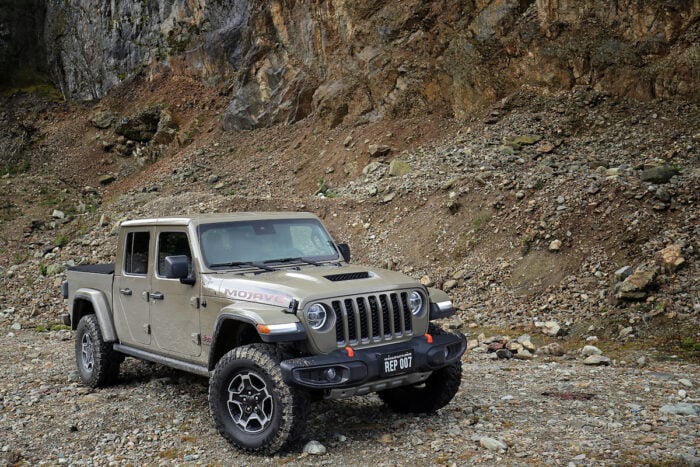
One of the routes I use for evaluating four-wheel-drive vehicles is comprised of a network of roads that traverse Mount Woodside, a popular recreational destination in the upper Fraser Valley. On this occasion, I discovered that the district crews had already been through to prepare the forestry roads for the winter, a period that usually brings along a seemingly endless deluge of rain. To prevent washouts, the crews cut ditches across the road in areas that are prone to substantial water movement. These ditches help effectively channel the water in a manner to protect the road surface but are deep enough that most road vehicles lack the ground clearance and traction to navigate through them.
Jeep Gladiator Rubicon: The Extreme Off-Roader
- Designed for extreme off-road capability with features like front and rear locking differentials

The Gladiator Rubicon performed so well that I tackled the mountain twice that week, giving me the opportunity to evaluate the vehicle in its favoured environment – off the pavement.
The Gladiator Rubicon is designed to conquer just about any task that the average off-road enthusiast would ask of it, including intermediate-level rock-crawling, an activity in which the driver selects a route that requires the vehicle to often drive up, over, and down seemingly impassable obstacles like boulders, rocks, ledges, and logs.
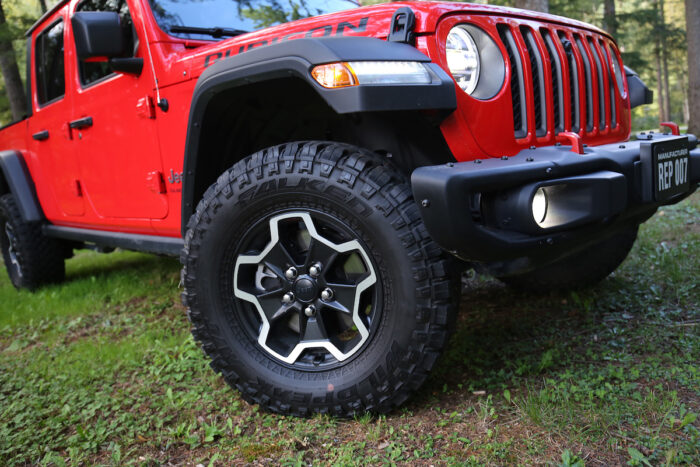
The technique requires plenty of concentration, slow speeds, and very careful and precise driver inputs. Rock crawlers typically feature large gear reductions in the drive train, heavy-duty axles and suspension components, front and rear lockers, and a full complement of skid plates. Jeep Wrangler Rubicon models excel at this activity off the showroom floor, and the Gladiator Rubicon is no exception once you get used to its longer wheelbase.
Also, check out our 2020 Gladiator Rubicon first drive review.
Jeep Gladiator Mojave: The Desert Runner
- Optimized for high-speed desert runs focusing on off-road performance at higher speeds.

Fast forward to the closing months of 2020, and I had the opportunity to spend a week with the newest Gladiator, the Mojave. The Gladiator Mojave is a premium model like the Rubicon, but instead of being a superstar on the rocks, the Mojave is designed to excel in the desert. Exclusive to the Gladiator lineup, the Mojave model has been outfitted to run at high speeds through sand and loose soil. In fact, the Mojave is the first Desert-Rated model for the Jeep and comes equipped with a gear set different from the Rubicon. It also has only a rear locker, as it has an open differential up front.

Like the Rubicon, the Mojave is blessed with high-performance Fox Racing shocks, albeit slightly beefier internal bypass units with an external reservoir (which allow increased fluid capacity and aid in shock cooling in extreme conditions), and hydraulic jounce bumpers up front. As running in sand is a much different discipline to rock crawling, the Mojave comes fitted with a dedicated sand tire, as well as a different spring rate which gives it slightly more ground clearance up front. The Mojave also features a fixed sway bar verses the electronic-disconnect front sway bar fitted to the Rubicon, as the former doesn’t require the articulation demanded by a dedicated rock-crawler.
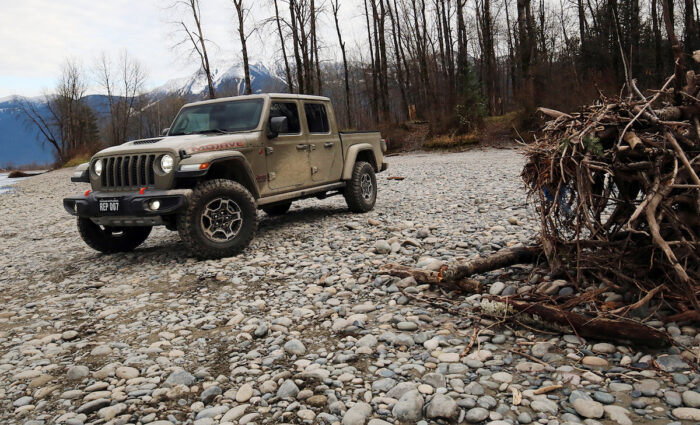
While obviously, my tests of the two trucks were not back-to-back, I did manage to travel the exact same routes as I navigated my way around Mount Woodside in both Gladiator models. Both Jeeps completed two expeditions up the mountain and both experienced similar weather conditions – dry one day, and wet and slick the other. Both managed to shine over two different routes to the summit, and both tackled the suspension-twisting final drop to the mountain’s famed hang-glider launch pad with relative ease.
Jeep Gladiator Rubicon Vs. Mojave: The Performance and Handling Differences

Both of our test rigs came equipped with the same Pentastar 3.6-litre V-6 engine under the hood mated to the optional eight-speed automatic transmission. This engine generates a healthy 285 horsepower and 260 lb-ft of torque. A six-speed manual transmission is standard, but the eight-speed proved to be a robust and smooth operating gearbox. Here’s a closer look at the Gladiator’s towing abilities.

Gladiator Rubicon buyers can click an option box for the 3.0-litre EcoDiesel V6 engine (260 hp/442 lb-ft) mated to a TorqueFlite 8-speed automatic gearbox. Gladiator Mojave buyers will have to make do with the Pentastar for now, which isn’t a bad thing, as it is well-sorted and delivers good torque, but there is talk that a Hemi V8 may find its way under the hood to help the truck sail through the desert like a proper pre-runner. The Gladiator Mojave also features a larger fan to facilitate cooler engine temperatures when operating in the desert.
Drivetrain and Off-Road Plus

The Jeep Gladiator Rubicon features Jeep’s Rock-Trac transfer case with a 4.0:1 low-range ratio, while the Mojave employs the Command-Trac transfer case with a 2.72:1 low-range ratio. The Mojave’s shorter ratio allows the vehicle to run at higher speeds when operating in low range, a trait that should help it paddle through deep sand. But don’t worry, should your journey incorporate more than sand, the Mojave can still crawl over most obstacles but without quite the finesse of the Rubicon.
Recognizing the need for traction at speed, the Mojave benefits from a driver-selectable feature called Off Road Plus, which will disable the Electronic Stability Program (ESP) at the touch of a button, allowing the rear locker to be engaged when operating in high range.
Suspension
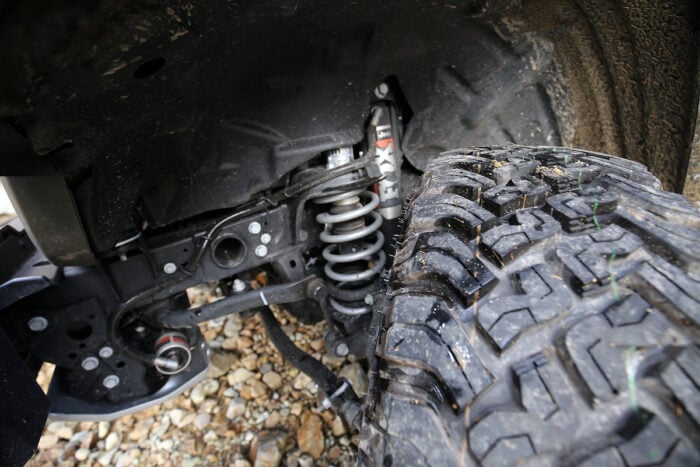
The engineers at Jeep have equipped both the Gladiator Rubicon and Mojave with beefier Dana 44 axles as they realize that both models may be asked to take a pounding. The presence of desert dunes tend to encourage jumping, or at least front-end launching berm blasts, so The Mojave sports cast-iron knuckles rather than the lightweight aluminum ones specified for Rubicon models. The frame, shock towers, and front control arms have been strengthened in strategic areas where repeated stress from impact and aggressive landings could result in significant chassis or suspension damage.
Jeep has partnered with Falken to produce model-specific 33-inch Wildpeak tires for both the Rubicon and Mojave models of the Gladiator. This is terrific news as Falken tires have a long history of producing high-performance off-road tires. However, Mojave wheels have been designed to extend the vehicle’s wheelbase just enough to promote better stability at high-speeds.
Gladiator Rubicon and Mojave Interior and Styling


On the styling front, the differences between the Rubicon and the Mojave are subtle. Red tow hooks are a signature for Rubicon, so orange is the new styling accent for Mojave. The steering wheel is wider than that in other Jeep offerings and features orange stitching, as do the seats (complete with an embroidered logo); while the alloy surround on the dashboard vents carry an almost tangerine shade of orange.

Steel bumpers have been replaced with polymer units but the vehicle does come equipped with steel rocker guards. The Mojave also sports a unique hood with a central faux vent and bold Mojave decals emblazoned on its flanks. The rear Jeep logo relief is also outlined in orange.
Takeaway
Pros:
- The Gladiator’s cargo box adds a new level of utility and will allow you keep the dirt outside the passenger cabin
- The Gladiator Rubicon and Mojave offer buyers a turn-key extreme off-road vehicle right off the showroom floor and complete with a factory warranty
Cons:
- Longer wheelbase makes the Gladiator a little less nimble than a traditional 4-door Wrangler design
- Big demand may add to the already hefty price tag
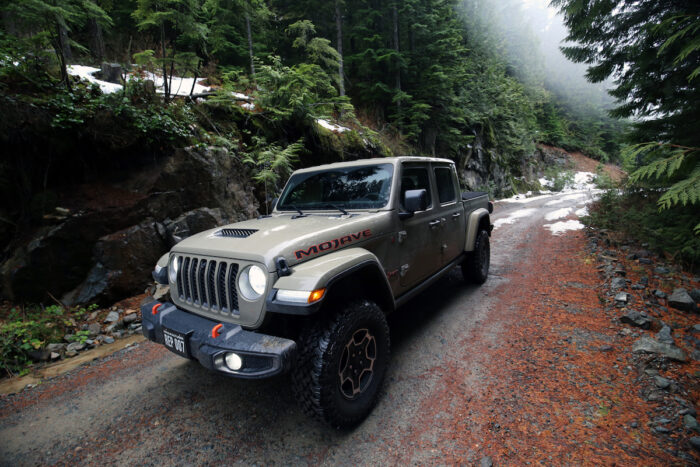
What sets offerings like the Gladiator Rubicon and Mojave apart from other vehicles is the fact that the product planners at Stellantis have engineered these off-the-shelf models to handle the most demanding terrain imaginable and outfitted them with top-quality, trail-tested equipment and components that carry a full factory warranty.

Prior to the arrival of the first Rubicon model almost 20 years ago, consumers would have to modify their Jeep with aftermarket equipment at huge costs of both time and money, and often with poor results. Judging by the recent entries from other auto manufacturers starting to percolate into the arena with similar attributes and aspirations it’s important to recognize that Jeep forged the trail and vehicle’s like the Gladiator Rubicon and Mojave are the benchmarks.
2021 Jeep Gladiator Rubicon / Mojave Specs:
- Type: 4-door, five-passenger, 4×4 pickup
- Layout: Front-engine, four-wheel drive
- Engine (As tested): 3.6L Pentastar VVT V6
- Horsepower: 285 @ 6,400 rpm
- Torque (lb-ft): 260 @ 4,400 rpm
- Transmission: 6-speed manual or optional 8-speed automatic
- Brakes: 4-wheel heavy-duty ABS disc brakes
- Payload: 1600 lb. / 726 kg.
- Towing Capacity: 7,650 lb. / 3,469 kg.
Jeep Gladiator Rubicon and Mojave Images
2021 Gladitaor Rubicon:
2021 Gladiator Mojave:


